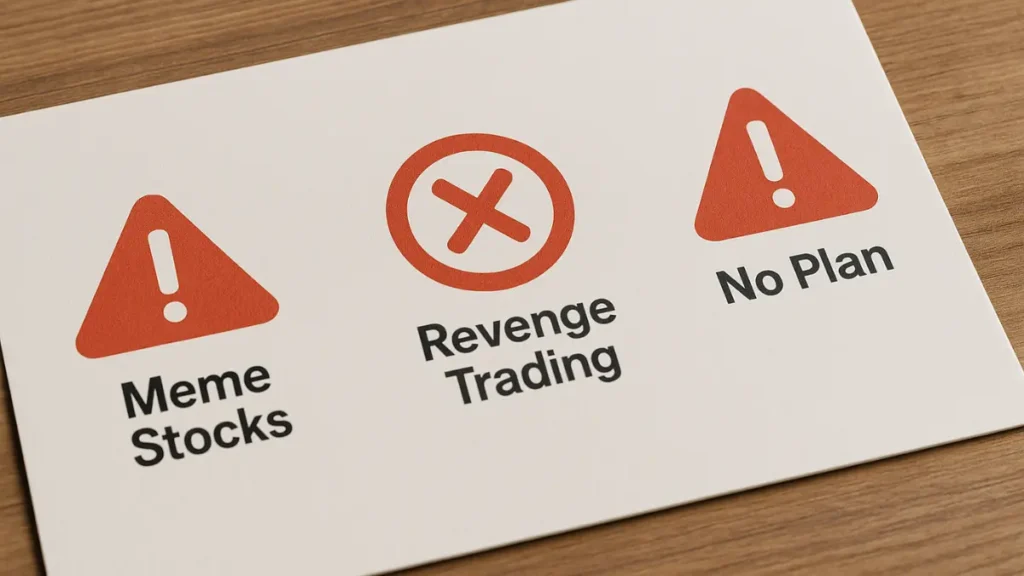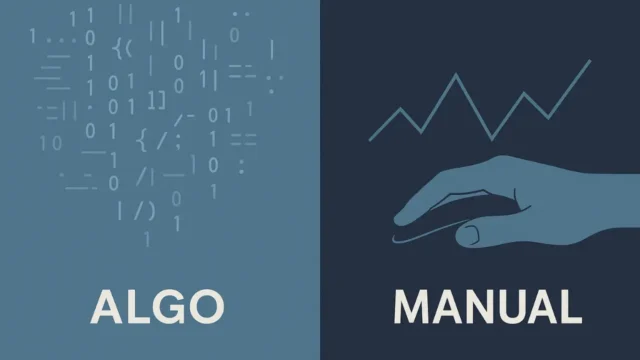Follow Us
How to Start Trading Stocks as a Beginner: Easy Steps for Beginners

Table of Contents
- Why Stocks Are the Gateway to Investing
- Understanding the Basics of Stocks
- Choosing the Right Broker & Tools
- Building Your First Trading Strategy
- Risk Management & Protecting Your Money
- Common Beginner Mistakes to Avoid
- Growing Your Skills as a Trader
Why Stocks Are the Gateway to Investing
If you have ever wondered how people “make money in the stock market,” you’re not alone. Millions of beginners turn to stocks as their first step into the world of trading and investing.
Stocks represent ownership in a company, meaning when you buy a share, you’re literally buying a piece of that business.
But for most beginners, the idea of trading stocks feels intimidating; complicated charts, financial jargon, and the fear of losing money can stop many before they even start.
Here’s the truth: you don’t need to be a Wall Street expert to begin trading stocks. With the right mindset, a beginner-friendly strategy, and simple tools, anyone can start learning the skill of trading step by step.
In this guide, I will break down everything you need to know about stock trading as a beginner, without overwhelming you.
Related Post:
81 Basic Stock Market Terms Every Beginner Must Know
Key Takeaways
- Stock trading helps beginners grow wealth while learning how businesses operate.
- Choosing the right broker/platform is your first major decision.
- Risk management is critical; controlling losses matters more than chasing profits.
- Consistent small wins build more wealth over time than gambling on hype stocks.
Understanding the Basics of Stocks
Before you place your first trade, it’s important to understand what you’re actually buying.
What is a stock?
A stock is a share of ownership in a company. If you buy Apple stock, you are essentially owning a slice of Apple. When the company does well, the value of your stock may rise. If it struggles, the value can fall.
Stocks vs other assets.
Unlike crypto (which is digital and highly speculative) or forex (which is based on currency exchange), stocks are tied to real companies with earnings, products, and long-term growth potential. That makes them a popular choice for beginners.
Common stock vs preferred stock.
- Common stock gives you voting rights and potential for higher returns, but also higher risk.
- Preferred stock usually doesn’t come with voting rights, but it pays steady dividends and is less volatile.
Why stock prices move.
Stock prices rise and fall because of supply and demand. If more people want to buy a stock than sell it, the price goes up. If more want to sell, it goes down. Key influences include:
- Company earnings reports
- Industry trends
- Economic news (interest rates, inflation)
- Market sentiment (fear vs. optimism)
Understanding this helps you avoid thinking the stock market is just “random.”
Setting Your Foundation Before Trading
One of the biggest mistakes beginners make is jumping in without preparing. Successful trading starts before you even buy your first share.
Step 1: Define your goals.
Ask yourself:
- Do I want to grow money long-term (investing)?
- Or do I want to trade short-term for quicker profits (trading)?
Your answer shapes your strategy.
Step 2: Build your safety net.
Never invest money you can’t afford to lose. Before trading, make sure you have:
- An emergency fund (3–6 months of expenses).
- No high-interest debt (like credit cards).
This way, stock trading won’t threaten your financial stability.
Step 3: Decide how much to start with.
Contrary to popular belief, you don’t need thousands of dollars. Thanks to fractional shares, many brokers let you start with as little as $10. The key is to start small, learn, and scale later.
Step 4: Shift your mindset.
Think of stock trading like learning a sport or a language. It takes time, practice, and discipline. If you see it as a lottery ticket, you are setting yourself up for disappointment.
Choosing the Right Broker & Tools
Your broker (trading platform) is your gateway to the stock market. Picking the wrong one can mean paying unnecessary fees or struggling with confusing software.
What to look for in a beginner-friendly broker:
- Low or no fees on trades.
- Easy-to-use and fast platform (mobile and desktop).
- Educational resources like tutorials and webinars.
- Paper trading option so you can practice without real money.
Popular beginner-friendly brokers in the U.S.:
Paper trading matters.
Many brokers let you trade with fake money in real markets. This is like flight simulation for pilots; practice first, then go live.
Building Your First Trading Strategy

Once your foundation is set and you have chosen a broker, it’s time to build a trading strategy. A strategy is simply a plan that guides when you buy, when you sell, and why. Without one, beginners often trade randomly and usually lose money.
Trading vs Investing
It’s important to understand the difference between trading and investing:
- Day Trading – Buying and selling within the same day, seeking small quick profits. Requires constant attention & high risk.
- Swing Trading – Holding for days or weeks, trying to profit from medium term price moves.
- Long-Term Investing – Buying and holding for years, benefiting from company growth and compounding returns.
For beginners, long-term investing or swing trading is usually safer than day trading.
Simple Beginner Strategies
- Buy & Hold – Pick strong companies you believe in (like Apple, Microsoft, or Amazon) and hold for years.
- Dollar Cost Averaging (DCA) – Invest a fixed amount (e.g., $100) regularly, regardless of price. This reduces the risk of buying at the wrong time.
- Exchange Traded Funds (ETFs) – Instead of betting on one stock, ETFs let you buy a basket of stocks (like the S&P 500). This gives instant diversification.
Researching a Stock
Before you buy, ask:
- Is the company profitable? (check earnings reports).
- Is the industry growing? (e.g., tech, renewable energy).
- What’s the news sentiment? (positive or negative headlines).
You don’t need to be a financial analyst; just get into the habit of asking “why am I buying this stock?”
Basic Technical Analysis
Technical analysis sounds confusing, but at its core it’s just studying stock charts. Beginners should focus on these basics:
- Candlesticks – Visual representation of price movements. Green = up, red = down.
- Support & Resistance – Support is a price where the stock usually stops falling; resistance is where it usually stops rising.
- Trendlines – Helps you see if a stock is generally moving up or down.
You don’t need advanced tools yet; just learn how to read a chart so you are not trading blindly.
Risk Management & Protecting Your Money
This is where most beginners either succeed or fail. Even the best strategy won’t save you if you ignore risk management.
The Golden Rule
Never risk money you can’t afford to lose. If you can’t sleep at night because of a trade, you have invested too much.
Stop-Loss Orders
A stop-loss is a tool that automatically sells your stock if it falls below a set price. Example: You buy a stock at $50 and set a stop-loss at $45. If the stock drops, you limit your loss to 10%.
Diversification
Don’t put all your money into one stock.
- Spread across industries (tech, healthcare, finance).
- Use ETFs if you want instant diversification.
Controlling Emotions
The stock market runs on fear and greed:
- Fear makes beginners sell too early.
- Greed makes them chase hype stocks (meme stocks, pump & dump schemes).
The best traders act logically, not emotionally. One way to control emotions is to plan trades in advance and stick to the plan.
Common Beginner Mistakes to Avoid

Even with preparation, many beginners fall into predictable traps. Avoid these early mistakes:
- Chasing Hot Tips & Meme Stocks
If everyone on social media is talking about a stock, you are probably late to the party. By the time beginners buy in, insiders are already selling. - Trading Without a Plan
Jumping into trades based on gut feeling is gambling, not trading. Always know your entry point, exit point & stop-loss before buying. - Ignoring Fees & Taxes
Even “free” brokers may charge hidden fees. Also, remember that profits are taxable (short term trading profits are usually taxed higher than long term, but it varies from country to country). - Overtrading & Revenge Trading
After a loss, many beginners immediately try to win back money by trading more aggressively. This often leads to even bigger losses.
The solution: accept small losses as part of trading. Protect your account balance above all.
Growing Your Skills as a Trader
Trading stocks is not something you master in a week; its a lifelong skill that improves with practice and reflection.
The goal as a beginner is not to get rich overnight, but to steadily grow your knowledge, discipline, and decision making ability.
Keep a Trading Journal
One of the most underrated tools in trading is a journal. Record every trade you make with notes like:
- Why you entered the trade.
- The price you bought and sold at.
- What went right or wrong.
Over time, this journal becomes a mirror of your progress. You will spot patterns, maybe you sell too early when nervous, or you chase trades after losses. Identifying these habits is the first step to fixing them.
Follow Financial News & Earnings Reports
The stock market doesn’t exist in a bubble; it responds to news. Earnings announcements, Regulatory meetings, and even political events can move stock prices dramatically. Beginners don’t need to follow everything, but try to:
- Read short daily market summaries (many brokers provide these for free).
- Pay attention to the earnings calendar of companies you invest in.
- Track major economic events (like interest rate announcements).
This helps you anticipate why prices move instead of being surprised.
Learn from Professionals
Instead of trying to reinvent the wheel, learn from those who have already mastered the game. Some ideas:
- Books like Market Wizards by Jack D. Schwager or How to Make Money in Stocks by William J. O’Neil.
- Podcasts & YouTube channels that break down market moves in beginner-friendly terms.
- Online courses offered by brokers or trading communities.
Think of it as professional training for your trading career.
Start Small, Scale Up
Beginners often think they need to go “all in” to make money. In reality, the best way to grow is:
- Start with very small trades (even $50 to $100).
- Focus on learning, not profits.
- Gradually increase your investment size as your strategy and confidence improve.
This way, your early mistakes cost you very little, but your lessons will be priceless.
FAQs
1. How much money do I need to start trading stocks?
You can start trading stocks with as little as $100. This amount is often enough for beginners to learn the basics and gain experience without taking on significant risk.
2. Is stock trading safe for beginners?
Trading stocks always carries risk. But with proper risk management, diversification & starting small, beginners can trade safely while learning.
3. What is the difference between day trading and long term investing?
Day trading involves buying and selling within a single day for quick profits. Long term investing means holding stocks for years to benefit from growth and compounding. For beginners, long term investing is usually safer.
4. Can I practice stock trading without risking real money?
Yes. Many platforms offer paper trading accounts where you can practice trades with virtual money in real market conditions.
Conclusion: Taking Your First Confident Step
Stock trading can feel overwhelming at first, but like any skill, it gets easier with practice.
The key lessons to remember are:
- Focus on knowledge and strategy, not hype.
- Protect your money with risk management.
- Start small, learn from mistakes, and scale as you grow.
Your first step doesn’t have to be buying a stock today, it can be opening a demo account, reading a beginner friendly investing book, or simply watching how the market moves this week. The important thing is to start.
If you are ready to take control of your financial future, explore more of Big Brain Money’s guides on trading and stock market. Each resource will help you gain confidence and take smarter steps toward your trading goals.
Disclaimer:
This content is for informational purposes only and should not be considered financial advice.
Read full Disclaimer.




